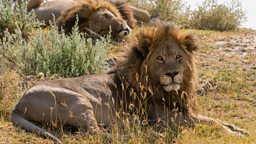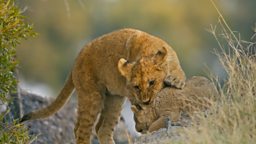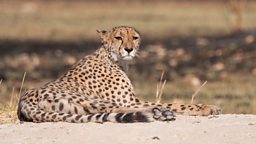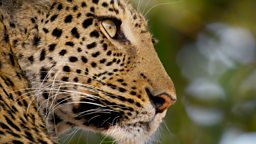Cat Spotlight: Tsebe
By Assistant Producer Tom Parry
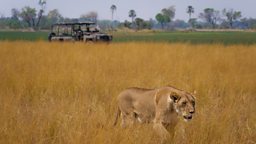
One of the great privileges while filming Big Cats 24/7 was following individual animals for months on end. Spending so much time with each character allows you to really get to know them.
As we followed, we realised she was skin and bones
The Xudum pride seemed to be endlessly growing during our six-month window into life in the Okavango Delta; by the time we left it contained more than forty lions, becoming possibly the largest pride in the entire world. Of all these amazing cat characters to work with, there was one that stood out for me – lioness Tsebe.
We met Tsebe during a particularly beautiful morning whilst on our usual patrol for signs of cat activity. As the sun rose and temperatures began to climb, we came across a lone lioness resting on the branch of a magnificent leadwood tree. She stood up, stretched her legs, gracefully descended, and headed off into the bushes. The buildup to the heat of the day usually marks a wind-down in lion activity, so we assumed she was off to find a shady place to relax with the rest of the pride. But no - she didn’t slow down. She walked purposefully away from the other lions into a floodplain towards a herd of antelope. As we followed, we realised she was skin and bones.
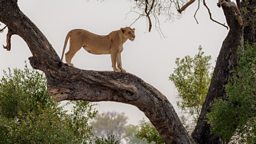
This kind of solo mission seemed very un-lion-like. Studies have shown that lions are twice as successful when hunting in pairs or groups, but Tsebe was going it alone. Throughout a particularly hot day, we watched in amazement as she went after lechwe, tsessebe, impala, warthogs – anything that moved – to no avail. She was doing everything right, but with no cover and no backup, the odds were always stacked against her.
Tsebe was going it alone
After a day of fruitless efforts, she trudged back into the savannah of Xudum Island and led us to a small pocket of trees away from the pride where we made an amazing discovery – she had cubs! In fact, she had five of them.
Less than 2% of lion litters contain more than four cubs, which perhaps isn’t surprising given that lionesses have only four teats. Lionesses in a pride share their milk with their sister’s cubs in a process known as ‘allosuckling’, a form of cooperation that is absolutely key to their success. Lactating lionesses produce the same amount of milk regardless of the number of cubs they have, so for lionesses with large litters like Tsebe, this kind of sharing is essential.
Unfortunately for Tsebe however, she had timed this litter badly. There were now fifteen cubs in the Xudum Pride, but at only a few weeks old Tsebe’s were too small to be introduced to the others. If Tsebe had formed a creche with the pride mothers, her cubs would have been in serious danger from overly playful older cubs, like Mathata.
On top of this, a lioness typically eats around 5kg of meat a day. One nursing cubs will need even more to meet the demands of the lactation. At only five years old, Tsebe was younger and less experienced than many of her fellow pride members. Yet – for now at least – she was eating for six and doing it all alone.

In the days that followed, I couldn’t help but admire the resilience and determination of Tsebe. As a film crew, she pushed us to our limit. A lion’s typical daily routine is reasonably chilled – as largely nocturnal hunters, they tend to be very inactive during the hottest parts of the day, limiting hunts to dawn, dusk and the night’s cover of darkness. But Tsebe, who had been up all night nursing her vulnerable cubs, would then slog out into the floodplains every morning in search of food, just as the heat was cranking up and the rest of the pride was snoozing in the shade.
she kept going day after day
We followed her for a week straight, watching in trepidation as she made increasingly desperate attempts to find a meal in the most gruelling conditions. Undeterred by failure, she kept going day after day, always returning to nurse that unusually large litter of cubs.
At one point she did eventually catch something, but it wasn’t the prey we expected. Another day of missed opportunities was drawing to a close and as we were preparing to return to camp, Tsebe suddenly began to stalk towards a patch of grass. She leapt, buried her head in the vegetation and emerged holding… a hare! We watched the most fearsome of predators – the biggest and mightiest of Africa’s big cats - eat a tiny hare. A chocolate bar to Tsebe, this was just a snack – but it was a lifeline. Feeding on these kinds of scraps was somehow keeping her and the cubs going.
It was a strange feeling spending so much time with one animal like this. As the days we followed Tsebe stretched into weeks, I felt like she had become part of the team. She was always there – accompanying our every conversation, bush meal and lens change.
We came to know her little mannerisms, to sense every move she was going to make – what she was thinking. It felt like we were forming a connection. And of course, as soon as we’d even mention putting the kettle on, she’d flick her tail or stretch her paws out in such a way that we knew she was about to move again, telling us the tea would have to wait and we’d better get ready for more action.
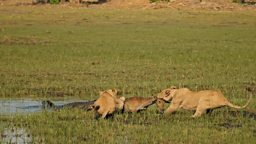
And what action it turned out to be. She had to battle a Nile crocodile to get it, but Tsebe got her meal eventually. Extremely dangerous, a crocodile of this size could easily have dragged Tsebe below the surface and enjoyed a decent lunch itself. But this is exactly what it takes for a lion to make it as a mum in this part of Africa – boldness and opportunism.
exactly what makes lions in the Okavango so special
Lions in the Okavango have learnt to take every opportunity this ever-shifting world presents to them. A crocodile with a recent kill still in its jaws was exactly that. It also helped that Tsebe finally had backup - it would be a few weeks yet before she could fully integrate into the pride and share those parental duties, but this much-needed meal wasn’t going to be missed and a passing pride lioness was the perfect teammate with whom to win it.
Watching a cat we’d come to really care about get increasingly desperate had tested us. Every instinct is to try and help, but – it may be a cliché but it’s true – our job was just to observe. I was so rooting for her, and the relief when she finally got a proper meal was palpable. Along the way, Tsebe had also given us a first-hand demonstration of exactly what makes lions in the Okavango so special – their remarkable resilience and their incredible adaptability.
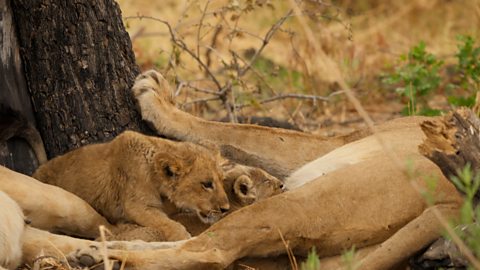
Tsebe suckles her new cub
New mother lioness Tsebe feeds one of her five tiny cubs as an older cub tries to push in.
